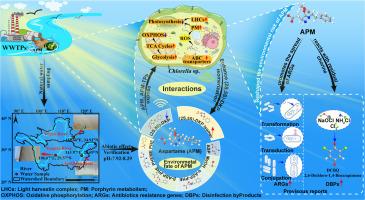与小球藻的串扰重塑了阿斯巴甜的环境命运:从应激反应到污染物不稳定
IF 12.4
1区 环境科学与生态学
Q1 ENGINEERING, ENVIRONMENTAL
引用次数: 0
摘要
阿斯巴甜(APM)促进抗生素抗性基因的传播,并与自来水中的余氯反应形成细胞毒性消毒副产物,提示潜在的生态风险。然而,作为主要生产者和生物指示物的微藻是否与APM及其转化产物(APM- tps)相互作用,或者微藻是否改变了它们的环境命运,从而重塑了APM相关的风险,目前尚不清楚。本研究发现,APM对小球藻生长的抑制呈浓度依赖性(抑制率为-16.6% ~ 24.4%),改变了光合色素的组成,诱导了氧化损伤。APM- tps的诱导实验证实(2S,5S) 5-苄基-3,6-二氧基-2-哌嗪乙酸((2S,5S)-DKP)是小球藻氧化应激的主要诱导剂。靶向和非靶向高分辨率质谱分析阐明了APM在水解、光解和小球藻条件下的转化途径。同时,长江、黄河和赣江水样中APM向(2S,5S)-DKP的转化率为75.6% ~ 97.0%,进一步阐明了APM在自然水系中的环境命运。值得注意的是,首次证实了小球藻催化(2S,5S)-DKP的异构化,异构率为46.7%。最后,通过转录组学研究揭示了小球藻氧化应激、光合损伤和能量代谢失调的机制。本研究全面阐明了APM与小球藻的相互作用机制,为APM和(2S,5S)-DKP的环境地球化学行为提供了新的认识。本文章由计算机程序翻译,如有差异,请以英文原文为准。

Crosstalk with Chlorella sp. Reshapes the Environmental Fates of Aspartame: From Stress Responses to Contaminant Destabilization
Aspartame (APM) is demonstrated to facilitate the dissemination of antibiotic resistance genes and react with residual chlorine in tap water to form cytotoxic disinfection byproducts, indicating potential ecological risks. However, it remains unclear whether microalgae, as primary producers and bioindicators, interact with APM and its transformation products (APM-TPs), or whether microalgae modify their environmental fates, thereby reshaping APM-associated risks. Here, we found that APM inhibited the growth of Chlorella sp. in a concentration-dependent manner (growth inhibition rate: -16.6% to 24.4%), altered the composition of photosynthetic pigments, and induced oxidative damage. Spiking experiments of APM-TPs confirmed (2S,5S) 5-Benzyl-3,6-dioxo-2-piperazineacetic acid ((2S,5S)-DKP) as the primary inducer of oxidative stress in Chlorella sp. Targeted and non-targeted high-resolution mass spectrometry elucidated transformation pathways of APM under hydrolytic, photolytic, and Chlorella sp. conditions. Meanwhile, the conversion of APM to (2S,5S)-DKP was 75.6%-97.0% in water samples from the Yangtze River, Yellow River, and Ganjiang River, further elucidating the environmental fates of APM in natural water system. Notably, the first evidence of Chlorella sp.-catalyzed isomerization of (2S,5S)-DKP, with an isomerization rate of 46.7%, was demonstrated. Finally, transcriptomics revealed mechanisms of APM-induced oxidative stress, photosynthetic impairment, and energy metabolism dysregulation in Chlorella sp. This study comprehensively elucidated the interaction mechanisms between APM and Chlorella sp., providing novel insights into the environmental geochemical behaviors of APM and (2S,5S)-DKP.
求助全文
通过发布文献求助,成功后即可免费获取论文全文。
去求助
来源期刊

Water Research
环境科学-工程:环境
CiteScore
20.80
自引率
9.40%
发文量
1307
审稿时长
38 days
期刊介绍:
Water Research, along with its open access companion journal Water Research X, serves as a platform for publishing original research papers covering various aspects of the science and technology related to the anthropogenic water cycle, water quality, and its management worldwide. The audience targeted by the journal comprises biologists, chemical engineers, chemists, civil engineers, environmental engineers, limnologists, and microbiologists. The scope of the journal include:
•Treatment processes for water and wastewaters (municipal, agricultural, industrial, and on-site treatment), including resource recovery and residuals management;
•Urban hydrology including sewer systems, stormwater management, and green infrastructure;
•Drinking water treatment and distribution;
•Potable and non-potable water reuse;
•Sanitation, public health, and risk assessment;
•Anaerobic digestion, solid and hazardous waste management, including source characterization and the effects and control of leachates and gaseous emissions;
•Contaminants (chemical, microbial, anthropogenic particles such as nanoparticles or microplastics) and related water quality sensing, monitoring, fate, and assessment;
•Anthropogenic impacts on inland, tidal, coastal and urban waters, focusing on surface and ground waters, and point and non-point sources of pollution;
•Environmental restoration, linked to surface water, groundwater and groundwater remediation;
•Analysis of the interfaces between sediments and water, and between water and atmosphere, focusing specifically on anthropogenic impacts;
•Mathematical modelling, systems analysis, machine learning, and beneficial use of big data related to the anthropogenic water cycle;
•Socio-economic, policy, and regulations studies.
 求助内容:
求助内容: 应助结果提醒方式:
应助结果提醒方式:


